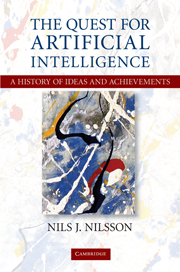Book contents
- Frontmatter
- Contents
- Preface
- PART I BEGINNINGS
- PART II EARLY EXPLORATIONS: 1950S AND 1960S
- PART III EFFLORESCENCE: MID-1960S TO MID-1970S
- PART IV APPLICATIONS AND SPECIALIZATIONS: 1970s TO EARLY 1980s
- PART V “NEW-GENERATION” PROJECT
- PART VI ENTR'ACTE
- PART VII THE GROWING ARMAMENTARIUM: FROM THE 1980s ONWARD
- 26 Reasoning and Representation
- 27 Other Approaches to Reasoning and Representation
- 28 Bayesian Networks
- 29 Machine Learning
- 30 Natural Languages and Natural Scenes
- 31 Intelligent System Architectures
- PART VIII MODERN AI: TODAY AND TOMORROW
- Index
- Plate section
31 - Intelligent System Architectures
Published online by Cambridge University Press: 05 August 2013
- Frontmatter
- Contents
- Preface
- PART I BEGINNINGS
- PART II EARLY EXPLORATIONS: 1950S AND 1960S
- PART III EFFLORESCENCE: MID-1960S TO MID-1970S
- PART IV APPLICATIONS AND SPECIALIZATIONS: 1970s TO EARLY 1980s
- PART V “NEW-GENERATION” PROJECT
- PART VI ENTR'ACTE
- PART VII THE GROWING ARMAMENTARIUM: FROM THE 1980s ONWARD
- 26 Reasoning and Representation
- 27 Other Approaches to Reasoning and Representation
- 28 Bayesian Networks
- 29 Machine Learning
- 30 Natural Languages and Natural Scenes
- 31 Intelligent System Architectures
- PART VIII MODERN AI: TODAY AND TOMORROW
- Index
- Plate section
Summary
Computer scientists have developed various ways to put together large programs consisting of many specialist subprograms. The traditional framework that controls the running of most programs involves having a main program that runs through its instructions step by step, retrieving from and storing data in memory, executing various operations on such data, and taking other allowed actions. Some of the instructions in the main program might be to “call” a subprogram, handing control over to it. The subprograms, in turn, can call other subprograms, and so on. After a subprogram finishes doing what it has been called to do, overall control returns to the program that called it, which might then call another subprogram, and so on until control finally returns to the main program. Eventually, the main program can finally quit running, having accomplished all that it was supposed to do, or it can continue running (in principle, forever) because, like a program that makes airline reservations on demand for all who use it, its work is never done. This scheme is the so-called von Neumann architecture.
There are many elaborations on this general idea. “Interrupts” can be included in programs and subprograms. These are ever watchful for special conditions within the computer system itself or in the environment – conditions, which if met, would call for control to be transferred immediately to programs that are able to handle such conditions. Computer operating systems, for example, depend on interrupts to be responsive to user inputs and to other things going on with the computer hardware.
Information
- Type
- Chapter
- Information
- The Quest for Artificial Intelligence , pp. 455 - 478Publisher: Cambridge University PressPrint publication year: 2009
